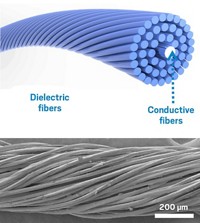Advertisement
Grab your lab coat. Let's get started
Welcome!
Welcome!
Create an account below to get 6 C&EN articles per month, receive newsletters and more - all free.
It seems this is your first time logging in online. Please enter the following information to continue.
As an ACS member you automatically get access to this site. All we need is few more details to create your reading experience.
Not you? Sign in with a different account.
Not you? Sign in with a different account.
ERROR 1
ERROR 1
ERROR 2
ERROR 2
ERROR 2
ERROR 2
ERROR 2
Password and Confirm password must match.
If you have an ACS member number, please enter it here so we can link this account to your membership. (optional)
ERROR 2
ACS values your privacy. By submitting your information, you are gaining access to C&EN and subscribing to our weekly newsletter. We use the information you provide to make your reading experience better, and we will never sell your data to third party members.
3-D Printing
Newscripts
Footwear feats
by Melissa Gilden
July 13, 2018
| A version of this story appeared in
Volume 96, Issue 29
Fleet of foot
Hoofers in no particular rush might just as well wear clogs. But for a marathoner, every millisecond counts. That’s why Nike designed its new Flyprint sneaker, the first with a three-dimensionally printed upper, the part of the shoe covering the top of the foot, especially for elite runners like Eliud Kipchoge, a Kenyan with an unofficial marathon-distance time of 2:00:25.

For a frame of reference, this Newscriptster just ran her first 5K—about a one-eighth marathon—at a breakneck pace of 32:13.
Nike is not the first major shoemaker to use 3-D printing. The Adidas Futurecraft and the Under Armour Futurist employ a 3-D-printed midsole, which makes for quicker development, less production-related waste, and higher customizability. However, Nike is the first to 3-D print the upper as a widely printed lattice for not only minimal weight but also smart protection against water absorption, which can add significant weight to the shoe and slow down the runner.
The Flyprint uses flexible thermoplastic polyurethane, which does not absorb water. The wide holes in the meshlike material allow water to easily escape. So even if you run those 26.2 miles (42.2 km) in a torrential downpour, your shoes “will weigh the same in the end,” says Brett Holts, Nike’s vice president of running footwear.
Kipchoge won the 2018 London Marathon while wearing the Flyprints, with a time of 2:04:17.
Keeping on her toes

While Nike 3-D prints running shoes with ultra-lightweight materials, professional ballerinas are still dancing on the tips of their toes, protected by what often amounts to layers of paper, cardboard, and glue.
Professional ballet dancers typically go through two or three pairs of pointe shoes per performance. The reason is the shank, the stiff center of the shoe, which with moderate wear can snap without notice. And at around $100 per pair, it’s enough to make a young ballerina, or her parents, do the same.
Abigail Freed was going through about a pair per performance before the idea dawned on her to redesign the shank of her pointe shoes. The 17-year-old decided to try carbon fiber; she wanted something flexible yet supportive and, most important, long lasting.
“I literally bought a roll of carbon fiber and a vacuum pump off Amazon and cured [the shanks] in my oven,” she tells the Newscripts gang. “I took a traditional pointe shoe, scooped out the old shank, and put mine in.”
And it works. While her dance colleagues are still going through a pair per performance, Freed has been dancing on her invention since December. She even has a provisional patent on the shoes, giving her a year to file a full patent, if she so chooses. The invention won her the Arconic Foundation’s Materials Science or Engineering, Third Award of $1,000 at the 2018 Intel International Science & Engineering Fair.
Advertisement
Freed has also thought about re-engineering other parts of the traditional pointe shoe, such as the box (which encases the dancer’s toes) and even the satin fabric that gives the shoe its traditional, graceful look. Then, she says, she’ll be able to make a shoe that really won’t break or fray.
The rising high school senior says she would like to major in mechanical or industrial engineering when she gets to college. It’s possible she will still be dancing in the same pair of carbon-fiber-reinforced pointe shoes then.
Melissa Gilden wrote this week’s column. Please send comments and suggestions to newscripts@acs.org.





Join the conversation
Contact the reporter
Submit a Letter to the Editor for publication
Engage with us on Twitter